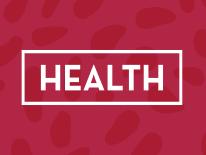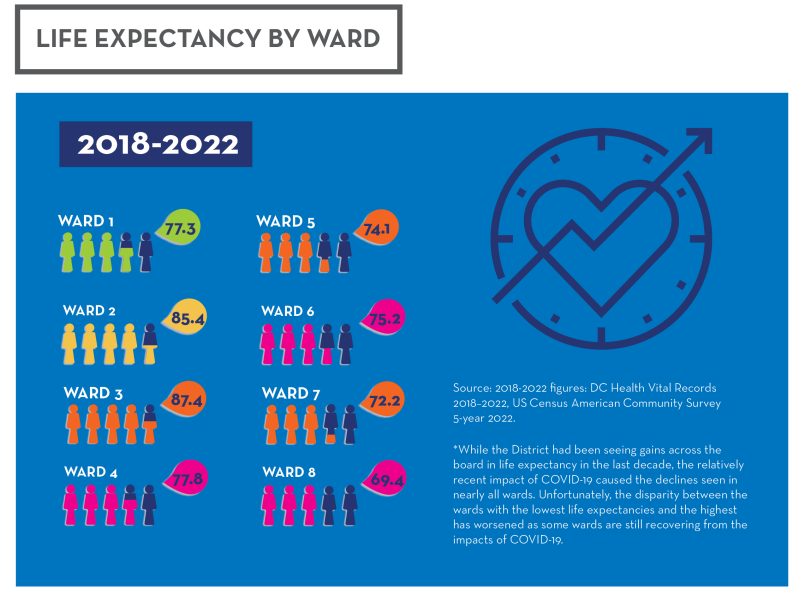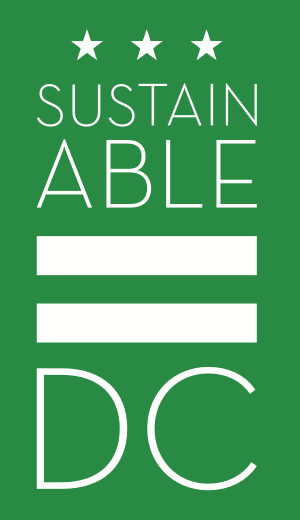

One of the District’s most important resources is the health of its residents, and DC is consistently ranked at the top of the country’s healthiest and fittest cities. Yet significant disparities in health exist along the lines of race, income, and geography. Good health starts in our homes, schools, workplaces, neighborhoods, and communities. After all, clinical care (direct medical treatment) drives only 20% of population health outcomes, with the remaining 80% generated by non-clinical determinants, also known as the social and structural determinants of health, according to DC Health's 2018 Health Equity Report. Effectively addressing health disparities requires focusing on the social and structural determinants of health: education, employment, income, housing, transportation, the food environment, preventative medical care, the outdoor environment, and community safety. By pinpointing actions to address these drivers, the District has an opportunity to alleviate differences in health outcomes and achieve greater health equity for all residents.

Goal 1: Provide residents with resources to achieve healthy, active lifestyles, regardless of income, ability, employment, or neighborhood
Status:  The average progress score of actions under this goal is between “Significant Progress” (3 out of 4) and “Completed or Institutionalized” (4 out of 4). See annual progress reports for details.
The average progress score of actions under this goal is between “Significant Progress” (3 out of 4) and “Completed or Institutionalized” (4 out of 4). See annual progress reports for details.
What's Been Done?
- FITDC is the District’s campaign to provide nutritional information and classes, as well as community workouts for all ages and fitness levels.
- The Department of Parks and Recreation tracks enrollment and programming data, and distributes surveys, to improve planning and programming decisions.
- The District has consistently ranked at or near the top in the Trust for Public Lands’ ParkScore Index, which ranks the 100 most populous U.S. cities by comparing five park categories: equity, access, investment, amenities, and acreage.
- The Department of Energy and Environment conducted a hyperlocal air quality monitoring pilot in 2023 in three communities disproportionately impacted by racial injustice and air pollution to increase residents’ awareness of pollutants and help reduce emissions.
What is Left to Do?
- Prioritize community-driven strategies to support physical activity in unexpected but everyday spaces.
Goal 2: Provide high quality, safe, and sustainable places to be healthy and active
Status:  The average progress score of actions under this goal is between “Moderate Progress” (2 out of 4) and “Significant Progress” (3 out of 4). See annual progress reports for details.
The average progress score of actions under this goal is between “Moderate Progress” (2 out of 4) and “Significant Progress” (3 out of 4). See annual progress reports for details.
What's Been Done?
- The District Department of Transportation hosts Open Streets events to encourage physical activity by hosting recreational activities, musical events, and more.
- The Department of Energy and Environment participated in the Centers for Disease Control and Prevention’s Lead‐Free Communities Initiative to identify new mechanisms for eliminating lead and other healthy homes hazards.
- The Healthy Homes program was established in 2012 and has addressed lead, mold, and other health hazards in hundreds of homes.
- The Department of Energy and Environment (DOEE) collaborates with the DC Housing Authority (DCHA) to identify DCHA-assisted property addresses likely to contain lead hazards for investigation and remediation.
- Through the District’s participation in C40 Cities, DC is included in the Healthy Neighbourhood Explorer Tool, which shows how DC and its neighborhoods rank on a variety of different indicators related to mobility and livability. The District also created an in-house Built Environment Indicators and Health interactive map tool to show information about built environment features that can influence health outcomes, based on the social determinants of health described in the 2018 DC Health Equity Report.
What is Left to Do?
- Complete a new study on the intersection between the built environment and health to understand the social, environmental, and economic barriers to healthy outcomes.
- Eliminate the human health impacts of contaminated sites in Washington, DC and identify areas where new authority is required.
- Improve public safety through the development and implementation of resident-driven design, programming, and maintenance of streetscapes, parks, and other public spaces.
- Audit and eliminate environmental health threats (mold, lead, and carbon monoxide) in 100% of Washington, DC’s public housing.
- Develop an interagency heat management strategy to minimize the injury rate associated with extreme cold and heat temperature days.
Goal 3: Improve population health by systematically addressing the link between community health and place, including where we are born, live, learn, work, play, worship, and age
Status:  The average progress score of actions under this goal is between “Moderate Progress” (2 out of 4) and “Significant Progress” (3 out of 4). See annual progress reports for details.
The average progress score of actions under this goal is between “Moderate Progress” (2 out of 4) and “Significant Progress” (3 out of 4). See annual progress reports for details.
What's Been Done?
- The Office of Planning in collaboration with DC Health conducted a pilot Health Equity Impact Review concurrent with the Congress Heights Small Area Plan process.
- The Department of Energy and Environment (DOEE) worked with the Department of Housing and Community Development (DHCD) to incorporate sustainable design requirements into DHCD's 2021 Consolidated Request for Proposals for funding to produce and preserve affordable housing in the District. These requirements appear in the mandatory threshold requirement to achieve 2020 Enterprise Green Communities Certification as well as priority consideration for projects that pursue other healthy design principles.
- DC Health has led the Advancing Health Literacy Project since 2021 with an overall goal of improving organizational, professional, and individual health literacy in the District.
What is Left to Do?
- Evaluate Health Impact Assessments as a tool for promoting health through new policies, practices, developments, and renovations.
- Study healthy community design principles for inclusion in all new affordable housing projects and major retrofits.
- Launch a comprehensive multi-level health literacy campaign across the District.
- Increase public awareness campaigns concerning how to prevent bites and control diseases spread by mosquitoes, ticks, and fleas in all communities.
Last updated: June 2025

